In the old days of 78 cent/gal gasoline, it was traditional to give a used older car to a teenager around the time they graduate high school. This was a sign they were acknowledged as having grown up a bit and earned the responsibility. The car was used to get to a job, go to college, dating, and would eventually lead to a better job, an apartment, and a marriage and family of their own. The car was the gateway to adulthood.
Now that oil is expensive and debt burden is huge, more and more young people are riding scooters and motorcycles to school and work because they are reasonably cheap to buy and very fuel efficient. Its not always comfortable, particularly when its rainy. But on the many dry days, of which there are around 300 a year in California, 83% of the time, they work just fine. Picking your machine is actually based on the distance of your commute, your required minimum speed, hills, road surface, and how that impacts your fuel economy. Realistically, you have to buy the right tool for the job.
I have ridden a Tomos Underbone scooter down in Newport Beach. It has an automatic transmission and spews great clouds of blue smoke. It goes up a hill about as fast as I do pedaling. But I don't have to pedal. The engine does the work for me. Nearly every other kind of scooter is better than that one, both in quality and capability. For Newport Beach it was great. Parking on Balboa Island, where I was staying, is minimal. Most people snag a space where they can find one, often blocks from their cottage, and bicycle or scooter across the bridge to the mainland for groceries. The cottages on Balboa Island are really close together, You can reach, almost, from one house to the next with outstretched arms. The weather in the summertime is fantastic, though. And with all the money there there's little crime so its very safe to let your kids play, to be neighbors with other rich kids. The future will probably have many examples of this sort of high density housing. I just hope that the cottages of the future are as varied and beautiful as the ones on Balboa Island. If they're all the same, the kids will grow up evil, like the ones in the Projects in Chicago. Mr JH Kuntsler is right about architectural variation being important to the human psyche. This is one of the reasons I find central valley towns, especially the ones north of Sacramento, to be so fascinating as they are highly varied, pre-car cottages for the most part, with an alley in the rear to the carriage house (garage) or park on the street. Most of these communities are flat with proper grids so you can actually use a 49cc scooter as intended. A Tomos or Vespa would work great there. So would a simple bicycle. I think those places are the next great Real Estate growth area. It depends a lot on jobs, though. Most are purely agricultural and repair, with minimal retail or other jobs available. They need to offer more crafts, more opportunities so people will stay instead of move into the Hellhole cities.
On the Pacific Coast Cities, hills are everywhere, potholes are common, and speeds are often high on the freeways, usually with poor or non-existent connections for frontage roads. This is a problem in my state. About the smallest safe, cheap vehicle on 2 wheels is the Ninja 250. Bought used they're around $2K, often with less than 12K miles. They are high revving engines, running to 14K RPMs but get around 70 mpg depending on how they're ridden. There are upgrades available for the brakes and suspension that makes them safer, and I suspect if I owned one I'd do that. Most people who have owned them liked them a lot, and said they brought a lot of joy back into riding a motorcycle. They're freeway capable but most fun on twisty canyon roads. Suzuki has a couple competitors like the GW250, a fuel injected twin. Honda has a fuel injected single, which has more torque, and a new 500cc sport bike which is more powerful and offers a good fuel economy balance for commuting. It could probably be ridden by a beginner safely and grow with them into a full commuter and sport bike. Kawasaki has upgraded the new Ninja to 300cc and Fuel Injection, which is a nice perk and might make it a more fun ride.
Road surface is important. Its what keeps the bike's wheel on the pavement. The combine contact patch of the front and rear wheel of most motorcycles is LESS than a single wheel on a Prius with its narrow tires and high pressure. You really have to be careful on those corners, on potholes or bits of slick manhole covers or strips of tar used to fix road cracks when money is short. They are called Tar Snakes by motorcyclist and they can kill you. Potholes in the PRK are often 2.5 inches deep, the typical thickness of a new layer of asphalt over the previous road surface. Motorcyclists dodge these because you will probably DIE if you hit one. You can limit the threat two ways: big wheels and long travel suspension. If you have small wheels and small suspension travel, like on a scooter, you are going down. As a scooter is slow, if there is a car behind you, you will probably be run over, very literally. Most people consider this a bad thing. The safest vehicle for really bad roads with potholes is a long travel suspension with four wheels. A subaru or truck or sedan, basically. They're popular for many reasons, but their safety in those conditions is unparalelled. No motorcycle is going to be as good. Its when the roads turn to mud bog and ruts that the motorcycle's value becomes obvious. The bike can go around, over or through more easily than a 4 wheel vehicle, and getting unstuck is a matter of lifting it out by brute force. You can't do that with an SUV. They weigh too much.
While the traditional wheel size of 10 inches is enough on good smooth pavement, its dangerous on rougher surfaces, which is mostly what we have here in the PRK. We have rough pavement and hills. Ergo, the 10 inch wheel on every 49cc Vespa is not a good idea here. That 10 inch wheel is what allows room for the flat floorboards on a scooter which make it so convenient. Put your package between your feet. You can shop with it. That's a really useful feature, like a pickup truck as many scooterists compare it. I really think the minimum wheel size on our roads should be 12 inches, and even that is taking a lot of risks with potholes. 14 inch wheels is loads safer than 10, as the physics keeps the bike moving forward out of a 3 inch deep pothole rather than stopping it dead and flipping over into traffic as a 10 inch wheel does. But big wheels removes those floorboards, and you lose some of that utility.
The safer the ride, the less useful the design for cargo (groceries). Most motorcyclists get around this with panniers, boxes or bags hanging on the tail of the bike to hold stuff, like groceries, your lunch, a computer, a shoulder bag. That kind of thing.
This is why Enduro bikes, which have the best suspension for rough roads on 2-wheels offer serious solutions. Supermoto setups on enduro bikes, such as the Suzuki DRZ0400SM are a good balance of power, fuel economy and a very good suspension. They can deal with rough roads, and pot holes you didn't see, without killing you because they have 11 inches of wheel travel and the suspension is usually set very supple, as you see with a Baja 1000 trophy racing truck, vehicles with 26 inches of suspension travel and famous for "bouncing" across the desert at full race speed.
Still, 4 wheels are safer. I encourage my readers to keep repairing their existing cars but ride a scooter or bike when the weather permits, for practice and to know what to expect should it become necessary as primary transportation. Wars can be sudden and the loss of access to fuel might happen very quickly, in a day or a week, thanks to troubles in the Middle East or Mexico or Nigeria. Things happen.
It IS legal to ride a ATV on the road, provided it has fenders and lights and turn signals and one rearview mirror. Make sure the turn signals work and the DMV will license it. You'll have to pay registration every year, but they assign you a license plate and a sticker and it's legal. ATVs are still out in the weather, but they have 4 wheels and still get decent mileage once you swap the tires and remember to lean hard on those corners. MPG isn't usually that great however, and a Geo Metro would offer more for the same price with better fuel economy too. Only do the ATV thing if that's all you've got and you get stuck otherwise.
Whatever you end up driving, you'll want to figure out a way to lock out its ignition so its harder to steal when you park it at work or the grocery store. You don't worry about that much with a car because its got a hard shell, but a bike or scooter can be lifted into a pickup truck by two strong men while you're buying milk and cookies inside. Happens. Accept that is a possibility every time you lock it and walk away.
Even if they don't steal it someone may still drill out your gas tank and steal your fuel. That's the big downside of a locking gas cap. Most people recommend no lock since replacing fuel is cheaper than replacing the tank spout or the tank itself. Or finding your vehicle on fire because the prick was smoking at the time. This has actually happened during the last gas price spike down in San Jose at an apartment complex, gasoline thieves, stealing fuel to buy methamphetamines, were smoking cigarettes as they drilled out the tank. They filled some containers, the lit the car on fire and ran away. The parking structure burned down and several other cars were destroyed. That will happen again. People tend to do the same sorts of stupid crap. I imagine the smell of gasoline will turn into a major Red Alert for the fire department and police in future 911 calls. Times are bad enough without burning down apartment buildings. It will probably encourage people to leave the ghettoes behind, though.
The following are my recommendations for commuter motorcycles/scooters based on terrain.
- Flat, slow street, short commutes under 12 miles: scooter, small motor 49cc, 120 mpg. Carb is fine and much cheaper. 2-stroke with monthly maintenance or 4 stroke and maintenance every 2000 miles.
- Hilly slow streets, reasonably smooth pavement: scooter, 125 cc 10-14" wheels. 4 stroke engine, 75 mpg.
- Flat rough streets: 125-250cc motorcycle, possibly used Enduro bike. 70 mpg, 4-stroke or 2 stroke. Appropriate suspension adjustments and tires for the surface, such as semi-knobby or slick depending on recommendations for experienced riders. A Ninja would work for this too.
- Hilly rough streets: 250cc Enduro bike, used, 4 stroke, good tires and suspension.
- Flat freeway: Ninja 250, used. 70 mpg, 100 mph top speed, decent brakes and acceptable suspension.
- Freeway with potholes and rough pavement: car. Don't risk this with a bike. Too many opportunities to die on this surface at freeway speed. People do, but they eventually wreck and die. Don't be one of them.
- Country road, flat: any cruiser or standard or supermoto bike is fine. Mind your speed into corners, and beware of loose pea gravel on driveway exits. Common as hell in the countryside. On a corner that will end you.
So ride cautiously and carefully. Read the manual for motorcycle safety. Take the class and get your license. It lowers your insurance rate. Excess speed and drunkenness are the real cause of most motorcycle accidents, which usually happen at corners. So don't drink when you ride and don't push it on corners and you're avoiding the major dangers. The other danger is car drivers not seeing you and pulling out. When you spot a car, be ready to brake and slow down enough you can stop if you must without hitting them. This is the other big danger. Those 3 issues are what will most likely threaten you as a motorcyclist. Defensive riding really is that simple.
As for crash safety and comfort, wear protective gear, at least some of it, usually a helmet, gloves and jacket are minimum. Wear appropriate for the weather conditions, and remember that wind chill can give you hypothermia in minutes on a bike so be warm enough.
For visibility to others, many riders prefer to keep their headlight on when in motion. Some like pulsing lights, which are distracting but do draw drivers attention. Most motorcyclists DO NOT RIDE AFTER DARK, for several reasons. The main one is that in corners you are blind. If you must work a night job or travel after dark, stick to using a car. Or move closer to your job so you can walk instead. Or get a job closer to where you live, same reason. Or get a job with human hours, during daylight.
Post oil, night jobs are going to be much less convenient and probably less safe in other ways too. Crime, remember? The closer you ride to dark, the better reason to wear protective gear with reflective stripes and good lights for the vehicle so it can be seen from all angles, easily. Bicyclists know this too. I have various lights for my bicycle from when I was commuting in traffic and after several weeks I gave it up as too dangerous despite it being a mere 2 miles. The gas I was burning was trivial compared to the daily dangers of distracted drivers with SUVs and Cellphones swerving into my bike lane and missing by inches.
This was part of why I started thinking hard about a scooter. When you are at the same speed as the traffic, they "see you" more easily. You stop being a pedestrian on wheels and start being part of the flow. I recommend any commuter remember they must keep up with traffic to be safe, but sometimes the right answer is frontage roads and stoplights rather than freeways. 2-land highway and roads seem to be safest for motorcyclists which is why you often see them there, motoring along.
While I love the look of the Vespa, it is overpriced, has tiny wheels, and a terrible suspension for California roads. It would only be suitable in flat places with very smooth pavement. Great for a college town, like Davis or Chico or Cal Poly or Stanford. Its popular in LA where there's sufficient money, and a few people up here have them. I don't see it as a good are sane choice, real world.
 |
| Deus is really good at building elegant bikes from junkers. |
I turned my attention to Vintage bikes. The old Triumph, BSA, Honda, and Suzuki are nice looking, but you need serious expertise to maintain them and repair their electrical faults. Most of these are being bought up and lovingly restored by retiring baby boomers, most at significant financial loss. They are happy though.
The Ninja 250 is a good bike, but I dislike its looks. Nothing vintage about it but its ignition system, since its carbureted. The closest thing to a vintage these days are called Naked bikes, such as the Suzuki TU-250x, which has the advantage of fuel injection in a bike that looks like a BSA Lightning clone, complete with wire wheels and a rear drum brake.
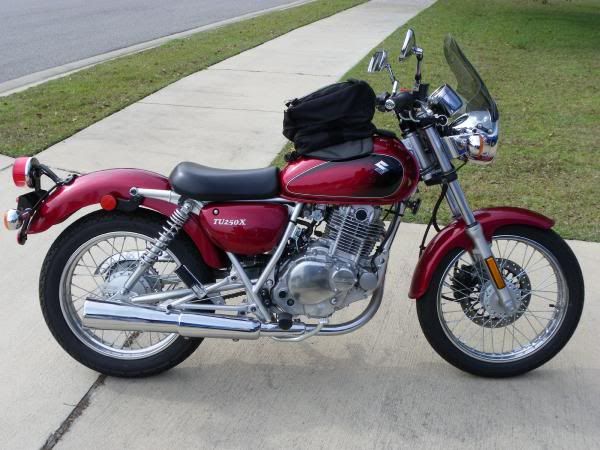 |
| All this and 75 mpg. |
I have not sat on one yet, however, so I don't know if its my size or small. If its too small for me I'll be looking at something else. I may even buy the GW250 or an Enduro to tidy up or possibly that new Honda CB500 due to that engine being pretty ideal for Sierra highway riding. Suzuki has a new 500cc as well. Its a good compromise for power and fuel economy and a serious contender for a daily rider.
Its listed as an adventure bike. I suppose with panniers for lunch and a camera it would be a nice way to reach Sardine Lakes for a picnic.
Then again, so would a Mazda Miata, and it has 4 wheels and you don't need all that riding gear. Just goggles and one of those english motoring caps. Whee! I realize that someday the fuel that allows us to move at all will be restricted, either by price or legal rationing, and we'll be daydreaming of the good old days when you slid a card, fueled up your vehicle, and drove as fast as you liked, same as any other fool. We had it good.
I like scooters because they are joyful on a warm sunny day. I like bicycles for the same reason. A motorcycle is probably the same. When its cold and wet, take a car. We'll need to find joy in our lives when the fuel is gone and we're stuck where we are. We can't dodge the future, nor can be pretend the basing our civilization on a fuel supply that runs out was a good idea. We have to live with it. But most of living with it is adapting our minds and how we think about things. If we can stop feeling entitled to cars and fast food and doing whatever we want just because we have money. Let all those old ideas go. Join the Present. For now, we still have gasoline. Next year? Who knows?
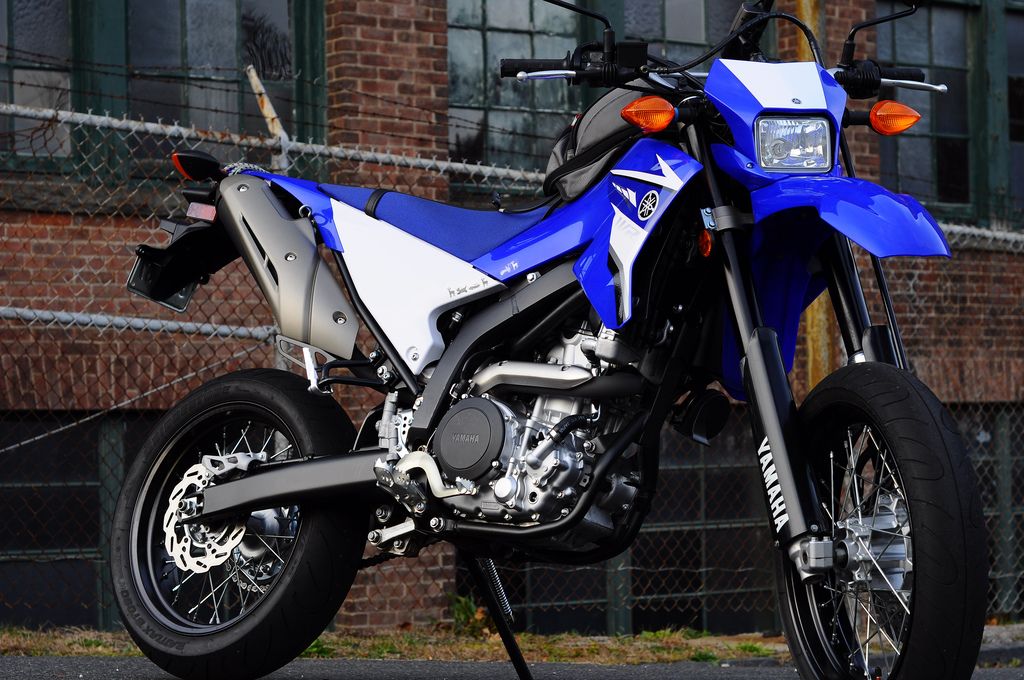
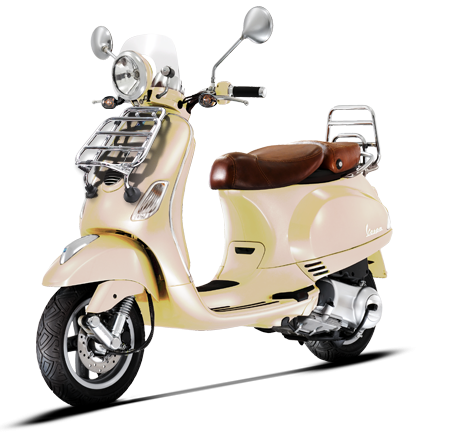
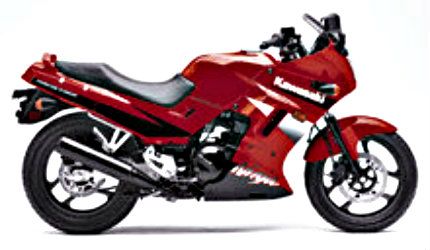

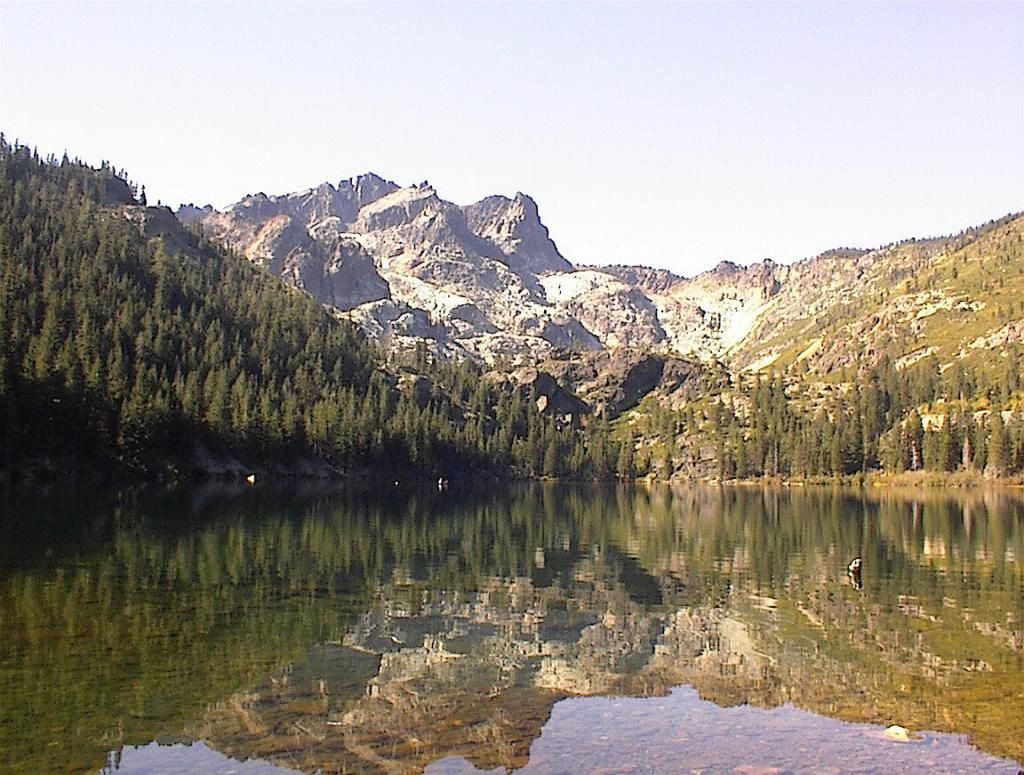
No comments:
Post a Comment